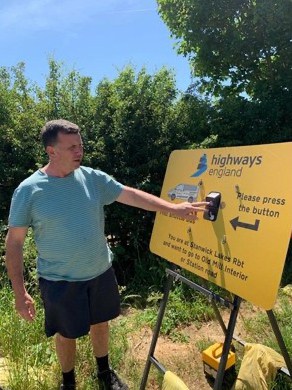Background
The scheme works removed an existing footway and alternative pedestrian routes. Using local footways as a diversionary route was not possible due to the significant increase in distance, unmade bridleways, and contained routes deemed unsafe during the hours of darkness or wet weather. A demarked pedestrian route within the site was not possible due to the TTM design having narrow lanes, the scope of the working area and the removal of the central refuge and use of concrete barriers to protect the public and workforce.
With no safe means for members of the public to safely cross the A45/A6 roundabout, a shuttle bus service was deemed necessary to assist pedestrians as part of the improvement scheme.
To ‘hail a ride’ on the shuttle bus, Customer Communication terminals (CCT’s) were installed at a number of safe areas, so that members of public could call for a free ride to take them from one side of the A45 to the other.

Solution
Between March 2020 when the CCT’s were installed, to December 2020, the CCT’s were used approximately 500 times per month, reducing costs and incursions whilst helping Chevron and Highways England to provide excellent levels of customer service.
CCT Technology
The Customer Communication Terminal can serve as either a two-way communication system, or support the relaying of a pre-recorded message which can be updated remotely at anytime. It can also provide diversion route information directly to users’ smartphones by using commonly used QR codes working alongside applications such as Google Maps. The terminal is self-contained and designed to be mounted onto an A-frame.
The Customer Communication Terminal helps improve communication with residents affected by road closures. It can reduce confrontation or frustration by providing help to the general public and reducing traffic management resource requirements. The sign face design can be customised to client requirements, which also provides a marketing opportunity.

Following a customer survey, information was circulated to the local residents with a clear message:
“To call the shuttle bus, please use the call points located at each pick up and drop off point”
“The HRS intercom system has been pivotal to the success of the shuttle bus and scheme, this enables members of the public to gain safe means across the A45 where all footpaths have been closed as part of our works
The technology gave the scheme a cost and a CO2 saving. Without the technology we would have had to have numerous men and vehicles sat manning the pickup points 24/7 over an eighteen month period.”
“Very pleased with the technology and glad it’s there, it’s a good way of keeping the pedestrian and traffic separate. Very useful project to keep the pedestrian safe. No issues with the technology, easy to use.”


